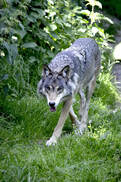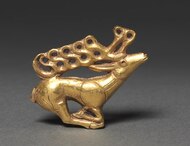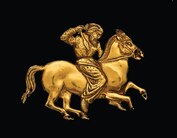| Plenty of writing craft books advocate ways to create plot-level tension and suspense, but few mention microtension, the secret sauce that keeps readers turning pages. In The Fire in Fiction, Donald Mass says, “Microtension is the moment-by-moment tension that keeps the reader in a constant state of suspense over what will happen, not in the story, but in the next few seconds.” Microtension is born from conflicting emotions—the inner conflict of the characters— and its key element is making readers uneasy so they have to keep reading to find out what happens next. |
- In dialogue, it’s not what characters say, but how their words reveal their internal conflicted emotional states.
- Action becomes tense when conflicting emotions are folded into the events, making outcomes more uncertain.
- Exposition and inner monologue also benefit from conflicting ideas and emotions to keep readers uneasy and engaged.
The opening scene of A Taste of Gold and Iron by Alexandra Rowland illustrates the uneasiness created by microtension in the author’s word choices:
- “acute relief” contrasted with “terror and worry” and “routine [birth]” → A self-aware character embarrassed by his intense, passionate emotions, which are exaggerated for the situation
- “prayed fervently” versus “breathe easy” → A pious person who knows he worries needlessly
- “days of celebration” and “daily concerns” contrasted with “alarming break-in,” “most blasphemous crimes,” “perplexing tantrums,” and “shaky nerves” → Subtext that all is not well despite the celebrations, and that the character struggles to fulfill his duties
Unease and reader questions infuse the opening scene of The Queens of Innis Lear by Tessa Gratton:
- “Scars and fresh scratches marred the rich tan of his back and arms” → A beautiful man unconcerned by fresh scratches and scars [What caused these scars?]
- “…the canopy of leaves chattered welcome.” → Are the trees actually speaking with him?
- “...[He] replied, That’s encouraging, in their tongue” → How can he speak with trees?
- “It had taken Bran months to win the trust of [these] trees, for he’d arrived angry and corded over by bitter flavors” → He is trustworthy yet full of anger and bitterness
- “He needed the rhythm under his skin to properly connect, to find the paths of magic he could use to track the loathsome Burgan army” → A powerful magician concerned with mundane war
- “Peace and solitude,” “tranquility,” “refreshed and blessed,” “where he might best catch hold of a wind willing to report on Burgun.” → Serenity contrasted with spying on his enemy
- “Ban rather liked his [scars] for how they proved his experiences and belonged to none but him” → An unexpected response to scars and being physically wounded.
| Writer Zara Altair recommends using juxtaposition to generate microtension: a contrast between what a character sees and what they hear, or an inner conflict created by a character wanting information but being unwilling to sacrifice their dignity to get it. She notes “each character has motivations. And each motivation is tied to an emotion.” Choosing words that highlight character motivations and emotions can help illuminate a character’s inner conflicts. |
Writes With Tools describes crafting creative tension through “oppositions, juxtapositions, and resolutions of seemingly contradictory ideas or feelings.”
She offers the following practical suggestions:
“Look for instances where you’ve made the punchline the topic sentence …when the [character] makes a conclusion then gives the reader evidence for drawing it. He’s a slob [summary]. His sink is full of week-old dishes. His bed is unmade… Instead, show what the character sees and then draw the conclusion…if you even need to. There’s no reason to repeat things the reader has figured out.”
This example also illustrates common writing advice of showing (dirty dishes, unmade bed) versus telling (He’s a slob).
She offers the following practical suggestions:
- Choose words with subtle nuances of tension (desire vs. lust) or contrary meanings (sweet sorrow, cruel kindness, admirable villain)
- Explore polarizing word pairs: impossible/necessary, powerful/helpless
- Show a character acting in a way that contradicts her stated desires
- “Make one character uncertain about or suspicious of the other character”
- “Make a character’s dialogue contrary to their goals, thoughts, body language”
- Reveal the character’s “emotions about the action…and what it might mean”
- “Tie setting, in some way, to inner tension” in the character
“Look for instances where you’ve made the punchline the topic sentence …when the [character] makes a conclusion then gives the reader evidence for drawing it. He’s a slob [summary]. His sink is full of week-old dishes. His bed is unmade… Instead, show what the character sees and then draw the conclusion…if you even need to. There’s no reason to repeat things the reader has figured out.”
This example also illustrates common writing advice of showing (dirty dishes, unmade bed) versus telling (He’s a slob).
More writing advice from Donald Maass: The Emotional Craft of Fiction





































 RSS Feed
RSS Feed